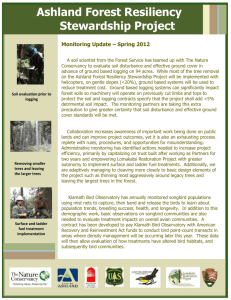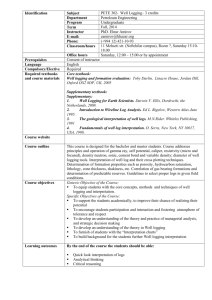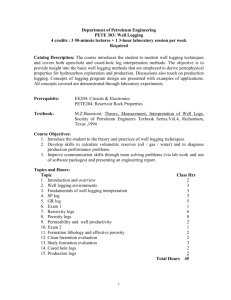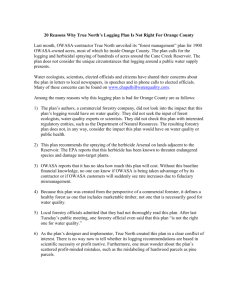PowerPoint
advertisement
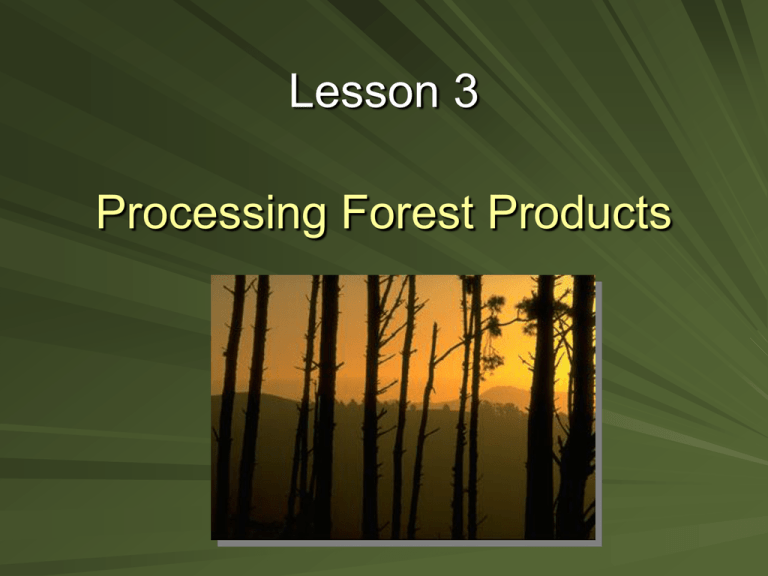
Lesson 3 Processing Forest Products Next Generation Science/Common Core Standards Addressed! RST.11‐12.7 Integrate and evaluate multiple sources of information presented in diverse formats and media (e.g., quantitative data, video, multimedia) in order to address a question or solve a problem. (HS‐LS2‐6),(HS‐LS2‐7),(HS‐LS2‐8) WHST.11‐12.8 Gather relevant information from multiple authoritative print and digital sources, using advanced searches effectively; assess the strengths and limitations of each source in terms of the specific task, purpose, and audience; integrate information into the text selectively to maintain the flow of ideas, avoiding plagiarism and overreliance on any one source and following a standard format for citation. (HS‐LS1‐3) Bell Work / Learning Objectives 1. Explain the harvesting and the logging plan of forest products. 2. Identify the logging activities. 3. Describe the processing of forest products. Terms Bucking Cants Cooperage Felling Fuelwood Green chain Kiln Kraft Limbing Oriented Stand Identify forest resources and explain how they were collected. Look at the available samples and determine how they were harvested, processed, and transported. Were the samples processed by machine or man? How are forest products logged and what is a logging plan? Harvesting or logging has been called the key to forestry. The best silvicultural plans are executed through the proper use of logging. The productivity of timber stands can be virtually destroyed by poorly planned or careless logging. How are forest products logged and what is a logging plan? The cost of logging is a major factor in the production of wood products. Timber is heavy, hard and difficult to handle. How are forest products logged and what is a logging plan? Logging costs are high, so efficient and economical harvesting is essential to sustained forest management yield. As a result of the rising costs logging must be carefully planned and integrated with silvicultural and forest protection activities. The logging plan should be a part of the total forest management plan. How are forest products logged and what is a logging plan? A logging plan may be as comprehensive as the forest management plan. Some of the general points of a logging plan are: 1. The location of cutting boundaries of the stand to be cut. – 2. The marking of the timber to be harvested (except when all the timber is to be cut). – A logging plan can be complex! How are forest products logged and what is a logging plan? The cruise of timber to be removed. – A cruise estimates timber volume by species and products, timber size, and location. The location of the most efficient log-loading sites. The location of skid trails and haul roads. How are forest products logged and what is a logging plan? The description of equipment to be used and the type of logging to be done; such as, short logs, long logs, or tree lengths. The location of emergency equipment storage points, including firefighting tools, first-aid containers, and other emergency equipment. What are the activities associated with logging? Logging is considered a dangerous occupation. What are the activities associated with logging? The activities associated with logging require persons skilled in woods work and the operation of logging equipment. – 1. Logging activities involve (1) cutting the trees (2) removing the limbs (limbing), (3) cutting the trees into lengths, (4) either skidding the logs to a central point for loading or loading pulpwood bolts at the general cutting area. What are the activities associated with logging? Each of these operations require special skills and equipment. Because of rising labor costs, equipment is utilized over labor whenever possible. • What are the activities associated with logging? Felling is the act of cutting or severing a tree from its stump. It involves cutting the tree in such a way that is safely falls in the desired direction and results in the least damage to the tree and surrounding trees. Tree Feller What are the activities associated with logging? Limbing is cutting branches off either felled or standing trees. What are the activities associated with logging? Bucking or cutting to length is cutting the felled trees into log or bolt lengths. The length of the log is dependent on the tree species and the desired final product. What are the activities associated with logging? Skidding is the part of the logging operation in which the logs are dragged from where they were cut to length to a central location for loading onto trucks or railroad cars. What are the activities associated with logging? Factors involved in skidding are similar to those involved in felling or cutting to length with the following exceptions: 1. The difference in weight of logs. – 2. The distance to skid. – 3. The amount of time required prior to skidding to bunch logs. – What are the activities associated with logging? Loading is lifting logs or bolts from the ground and placing them on trucks, trailers and railroad cars. Care is taken to compact the load so that it will withstand the jostling action during hauling. What are the activities associated with logging? Small pulpwood bolts are loaded by hand. Large logs are loaded with a drumpowered cable wench on trucks, hydraulic cranes, front-end hydraulic loaders, large cable cranes and cables attached to the tractor skidders. What are the activities associated with logging? Most logs and bolts are hauled from the woods by trucks to a wood-using mill or to a railroad siding, where they are reloaded for shipment to a distant mill. Every size and type of truck manufactured is used to haul bolts and logs. What are the activities associated with logging? New logging equipment, called whole tree chipper system, cuts and chips the whole tree and hauls the chips to pulp and paper mills, building board plants, cedar oil mills, and other units that use tree chips in their manufacturing processes. What are the activities associated with logging? Machines are also being used to lift the entire tree from the ground. The advantage of removing the entire tree that the stump and roots, which are normally wasted, are utilized along with the above-ground portion of the tree. How are forest products processed? III. Once logs or bolts reach a woodusing firm, they may be debarked, sawed, shaped, peeled cooked, burned, glued, or dried. How are forest products processed? A. These treatments result in the production of lumber, paper, plywood, building boards, poles and piling, railroad cross-ties, fence posts, furniture, handles, charcoal, and a large variety of other products. How are forest products processed? When logs arrive at a sawmill, they are generally stored until needed for processing. At fully integrated operations, treelength logs are utilized according to their most efficient use. How are forest products processed? The lumber may be stacked in the yard for air-drying or loaded onto special cars for entry into dry kilns. In kilns, the lumber is rapidly seasoned under controlled conditions to reduce the moisture to levels suitable for the area in which the lumber will be used. Lumber Drying Kiln How are forest products processed? Some mills have planning units that surface or smooth the rough lumber. – In this case the grading takes place after surfacing. The sawdust is conveyed to a storage bin and will eventually be sold to pulp and paper mills. How are forest products processed? Innovations of automating sawmill operations: – – – At very high rates of speed, electronic sorters automatically stack the lumber by size. Closed-circuit TV allows machine operators to control equipment that is hundreds of feet away. Computers monitor many of the milling operations. How are forest products processed? X-ray machines and computers scan logs and instantly decide the most profitable way for headsaws to cut them. Computerized headsaws boost rough lumber recovery to 60 percent. Thin saw blades reduce sawdust volumes by 5 percent. How are forest products processed? Laser beams and water-jet headrigs may eliminate most sawdust and the need for some lumber planing. Electro-mechanical machines can measure the stiffness and strength characteristics of individual pieces of lumber. The lumber can then be stamped a strength value and marketed as stress rated or stress graded. How are forest products processed? Paper has been around for about 2,000 years. Cooking wood fiber in a chemical solution is the most widely used method of making pulp. How are forest products processed? When pulpwood bolts or logs arrive at a mill, they are stored in huge piles for later use. – a. From the stacks, the pulpwood moves by conveyors to debarking machines, where the logs are tumbled together in huge drums or sprayed with high pressure jets to remove the bark. How are forest products processed? The bolts move to large chippers that slice off small wood chips for the chemical process or to large, coarse grindstones that reduce the bolts to short fibers for the ground wood process; the latter method is used to make much of the country’s newsprint. How are forest products processed? To make paper, the cellulose must be chemically separated from the lignin binder by cooking the wood in sulfite, soda or sulfate solutions. How are forest products processed? This is done in digesters or huge pressure cookers, where the wood and the chemicals are cooked under steam pressure that reduces the whole to a mass of wet pulp. The chemicals are removed and the pulp is thoroughly washed. How are forest products processed? From this stage, the wood pulp goes through beaters that separate the individual fibers. Often sizing (for smoothness and water resistance), bleach, and color are added during this process. How are forest products processed? In the final step, the wet pulp enters the Fourdrinier paper machine. The pulp is sprayed onto a wire screen that allows the wood fibers to interlace while the water is drawn off. How are forest products processed? From the screen, a continuous mat of wood pulp moves onto a belt of wool felt and then through a series of rollers that press more water out. – The material then moves into the dry end of the Fourdrinier through a series of heated rollers called dryers. e. Finally, the finished product is wound into rolls that vary in width and weight. How are forest products processed? Paper mills turn out a variety of materials, from raw pulp, to giftwrapping paper, newsprint, magazine and book stock, writing paper, milk carton stock, bond, wax paper, and kraft. Kraft is the paper made into brown paper grocery bags, cardboard boxes (called liner board) and similar products. How are forest products processed? Some building materials, such as roofing felt and fiberboard, are also made during the pulping process. How are forest products processed? Wood pulp is used to manufacture other non-paper products: rayon, cellophane, nitrocellulose, acetate plastics, photographic film, smokeless gun powder, tire cord, cellophane tape, telephone parts, plastic handles, toys and many other products. How are forest products processed? Plywood is manufactured from three or more sheet of veneer glued together, with the grain of alternate sheets running at right angles for strength. – a. Plywood is used for paneling, sheathing, furniture, concrete forms, sporting equipment, and hundreds of other uses. How are forest products processed? When veneer or plywood logs arrive at a plant, they are cut into lengths to fit the lathe or veneer-cutting equipment. – a. Logs are usually heated for several hours in vats of hot water or stem chests. This aids removal of bark and softens the wood for easier cutting. How are forest products processed? The logs are moved to the lathe or veneer-cutting machine with a mechanical hoist. A log is turned in the lathe to peel off a thin sheet of continuous rotary veneer, or it is sliced or sawed into sheet by veneer-cutting machines. Plywood Lathe Summary / Review 1. Explain the harvesting and the logging plan of forest products. 2. Identify the logging activities. 3. Describe the processing of forest products. The End!
